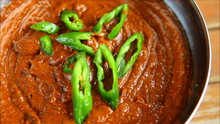Ssamjang
 | |
| Type | Condiment |
|---|---|
| Place of origin | Korea |
| Associated cuisine | Korean cuisine |
| Main ingredients | Gochujang, doenjang |
| Korean name | |
| Hangul | 쌈장 |
|---|---|
| Hanja | 쌈醬 |
| Revised Romanization | ssamjang |
| McCune–Reischauer | ssamjang |
| IPA | [s͈am.dʑaŋ] |
 |
| This article is part of a series on |
| Korean cuisine 한국 요리 조선 료리 |
|---|
Ssamjang (Korean: 쌈장) is a thick, spicy paste used with food wrapped in a leaf in Korean cuisine. The sauce is made of fermented soy beans (doenjang), red chili paste (gochujang), sesame oil, onion, garlic, green onions, and optionally brown sugar.[1][2][3][4]
Etymology[edit]
Ssam means "wrapped" and jang means "paste" or "thick sauce". Together as ssamjang they mean "wrapping sauce".
Variations[edit]
Besides the standard way of making ssamjang, other ingredients can be added to make special versions.[5] There are also commercially prepacked ssamjang available on the market.[6]
- Nut ssamjang (견과류 쌈장): ground walnuts, pumpkin seeds, sunflower seeds, and other nuts are added
- Jjukumi ssamjang (쭈꾸미 쌈장): diced short-arm octopus is stir-fried with diced red peppers and onions, and mixed together with ssamjang
- Tofu ssamjang (두부 쌈장): crushed tofu is added
- Flying fish roe ssamjang (날치알 쌈장): flying fish roe is added
- Namul ssamjang (나물 쌈장): various beans are diced and added
- River snail ssamjang (우렁이 쌈장): boil the water with doenjang, river snail, green onion, garlic, and red pepper powder.[7]
See also[edit]
References[edit]
- ^ (in Korean) Ssamjang at Doosan Encyclopedia
- ^ "Ssam Jang".
- ^ "Ssamjang Recipe hannaone". Chowhound.
- ^ "Korean Food | Ssamjang | Mixed Soybean & Chili Pepper Paste". www.trifood.com. Archived from the original on 2011-07-14. Retrieved 2021-01-24.
- ^ (in Korean) Mom's ssamjang, Segye Ilbo, 2010-04-15.Retrieved 2010-06-25.
- ^ (in Korean) Comparison of ssamjang, Sports Seoul, 2009-03-19. Retrieved 2010-06-25.
- ^ "우렁이쌈장". terms.naver.com (in Korean). Retrieved 2021-05-16.
